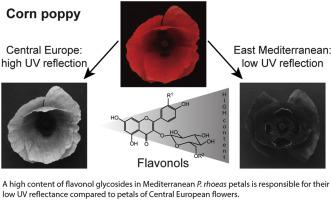当前位置:
X-MOL 学术
›
Phytochemistry
›
论文详情
Our official English website, www.x-mol.net, welcomes your
feedback! (Note: you will need to create a separate account there.)
Highly different flavonol content explains geographic variations in the UV reflecting properties of flowers of the corn poppy, Papaver rhoeas (Papaveraceae)
Phytochemistry ( IF 3.2 ) Pub Date : 2020-10-01 , DOI: 10.1016/j.phytochem.2020.112457 Bettina Dudek 1 , Bernd Schneider 1 , Hartmut H Hilger 2 , Doekele G Stavenga 3 , Jaime Martínez-Harms 4
Phytochemistry ( IF 3.2 ) Pub Date : 2020-10-01 , DOI: 10.1016/j.phytochem.2020.112457 Bettina Dudek 1 , Bernd Schneider 1 , Hartmut H Hilger 2 , Doekele G Stavenga 3 , Jaime Martínez-Harms 4
Affiliation

|
Papaver rhoeas, the corn poppy, is a very common weed in cereal fields all over the world. Its flowers generally display a bright red coloration, but their reflectance in the ultraviolet (UV) wavelength range varies geographically. Whereas the UV reflectance of East Mediterranean flowers is minor, that of Central European ones is substantial. By comparing the pigmentation of the differently reflecting flowers, we found that only East Mediterranean flower petals contain high amounts of UV absorbing flavonol glycosides. The most abundant compounds were isolated by solid phase extraction and preparative HPLC, and their structures were elucidated by NMR and HRESI-MS, yielding seven kaempferol and quercetin glycosides, mostly unknown in P. rhoeas petals. Additionally, reflectance and transmittance measurements revealed that wavelength-selective scattering effects do not contribute to the flower color differences observed within this species. Possible abiotic and biotic factors influencing the UV reflecting properties of East Mediterranean and Central European poppies are discussed.
中文翻译:

高度不同的黄酮醇含量解释了罂粟花的紫外线反射特性的地理差异,罂粟科 (Papaveraceae)
罂粟,即玉米罂粟,是世界各地麦田中非常常见的杂草。它的花朵通常呈现鲜红色,但它们在紫外线 (UV) 波长范围内的反射率因地域而异。东地中海花卉的紫外线反射率较小,而中欧花卉的紫外线反射率很高。通过比较不同反射花的色素沉着,我们发现只有东地中海花瓣含有大量吸收紫外线的黄酮醇苷。通过固相萃取和制备型 HPLC 分离出最丰富的化合物,并通过 NMR 和 HRESI-MS 阐明了它们的结构,产生了七种山奈酚和槲皮素糖苷,大部分在 P. rhoeas 花瓣中是未知的。此外,反射率和透射率测量结果表明,波长选择性散射效应对在该物种中观察到的花色差异没有影响。讨论了可能影响东地中海和中欧罂粟的紫外线反射特性的非生物和生物因素。
更新日期:2020-10-01
中文翻译:

高度不同的黄酮醇含量解释了罂粟花的紫外线反射特性的地理差异,罂粟科 (Papaveraceae)
罂粟,即玉米罂粟,是世界各地麦田中非常常见的杂草。它的花朵通常呈现鲜红色,但它们在紫外线 (UV) 波长范围内的反射率因地域而异。东地中海花卉的紫外线反射率较小,而中欧花卉的紫外线反射率很高。通过比较不同反射花的色素沉着,我们发现只有东地中海花瓣含有大量吸收紫外线的黄酮醇苷。通过固相萃取和制备型 HPLC 分离出最丰富的化合物,并通过 NMR 和 HRESI-MS 阐明了它们的结构,产生了七种山奈酚和槲皮素糖苷,大部分在 P. rhoeas 花瓣中是未知的。此外,反射率和透射率测量结果表明,波长选择性散射效应对在该物种中观察到的花色差异没有影响。讨论了可能影响东地中海和中欧罂粟的紫外线反射特性的非生物和生物因素。











































 京公网安备 11010802027423号
京公网安备 11010802027423号